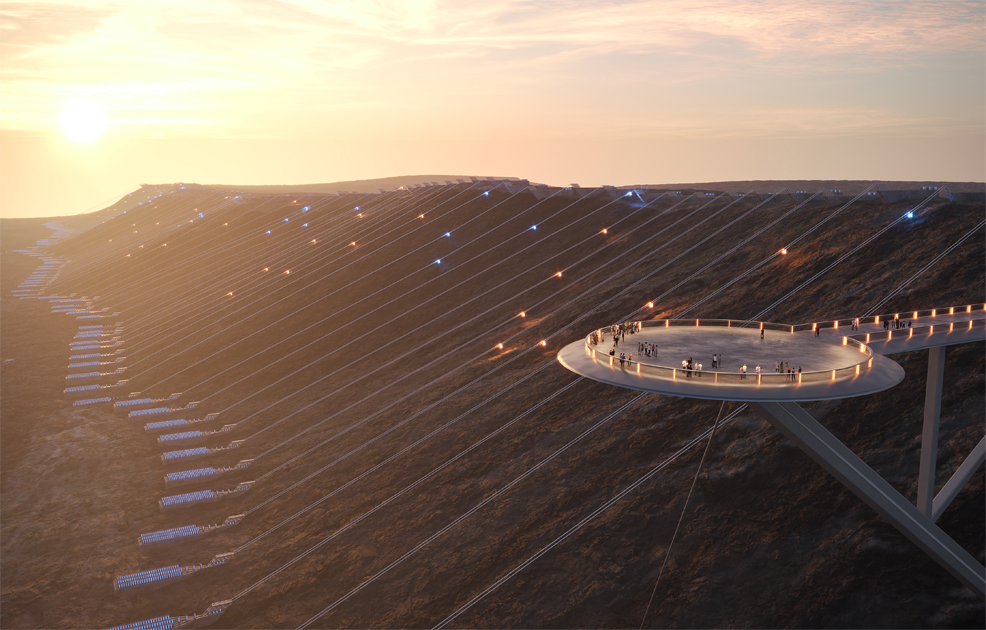
10th June 2024 Futuristic battery concepts revealed Skidmore, Owings & Merrill, in partnership with Energy Vault, has unveiled a series of energy storage concepts, including structures that could reach up to a kilometre in height.
Skidmore, Owings & Merrill (SOM), a leading architecture and engineering firm, is known for designing some of the world's most iconic skyscrapers, such as the John Hancock Center (1969), Sears Tower (1973), Jin Mao Building (1999), Burj Khalifa (2009), and One World Trade Center (2014). The company has just unveiled its latest project – a new generation of gravity energy storage systems (GESS), which are set to be developed in collaboration with Swiss-based Energy Vault. As part of this strategic partnership, SOM will be the exclusive architect and structural engineer for the fixed frames and deployable structures on GESS facilities planned by Energy Vault. This includes using GESS technology in both urban and natural environments to maximise sustainability, accelerate carbon payback and reduce the levelised cost of energy consumption. Energy Vault has already begun working with SOM to optimise the structure, architecture, and economics of these proposals.
Gravity-based energy storage involves lifting heavy weights to store energy and then lowering them to release that energy when needed. This method leverages gravitational potential energy, providing a sustainable and efficient solution for energy storage and distribution. G-VAULT is a family of gravity-based solutions being developed by Energy Vault. These combine time-tested energy principles with modern engineering and cutting-edge materials, as well as AI software. G-VAULT is designed for long-term use, providing 35 years without degradation, while utilising eco-friendly processes that contribute to a circular economy. Safety is also a key feature – no electrochemical reactions occur and there is zero need for fire protection. To date, Energy Vault's G-VAULT product suite has focused primarily on the company's EVx platform, originally grid connected (5 MW) and tested in Switzerland, which features a highly flexible and modular architecture that can scale to multi-GW-hour storage capacities. The EVx is currently being deployed in China (3.7 GWh of announced projects), Egypt, Greece, and 16 countries in the South African Development Community (SADC). The energy storage needs of the SADC are projected to reach 25 GW/125 GWh by 2035. A 10-year agreement between Energy Vault and this region – involving multi-GWh of added capacity – will help significantly in meeting its demand. Through their newly announced partnership, Energy Vault and SOM are now designing a new platform of G-VAULT solutions focused on improved economics, energy density, and sustainability. These are named EVu, EVc, EVy, and EV0. EVu, the first of the giant towers pictured above, will provide a way of integrating GESS into supertall buildings with heights of more than 300 metres (984 ft), and potentially up to 1,000 m (3,281 ft). These structures will have the capacity to reach multi-GWh of storage, not only powering the building itself but also adjacent buildings. According to Energy Vault, this technology will enable a carbon payback (how long it takes a project to offset the greenhouse gases emitted from its construction) within accelerated timeframes of 3-4 years. EVc, the second building presented above, aims to demonstrate the first ever deployment of large-scale, pumped hydro energy storage systems integrated within supertall structures using a modular water-based system. Its cylindrical shape is optimised to withstand environmental factors such as wind and seismic events. In addition to large-scale energy storage, both EVu and EVc can incorporate mixed residential use. Their designs also make them flexible enough to be constructed almost anywhere in the world. Next on the list is EVy, which applies gravity technology to pre-existing slopes and topography to store energy with a minimal environmental impact and reduce the need for human-made structures. According to Energy Vault, this can achieve "ultra-low-cost capital expenditures through eliminating the construction of the fixed frame structure."
EV0, the fourth and final concept, allows for all the technical and economic benefits of traditional pumped hydro storage, while eliminating negative consequences associated with concrete production and disruption to existing ecosystems. This "modular pumped hydro" system leverages a unique and low-cost fabric vessel (the "Water Tree") to store water in pre-manufactured modules, which can be deployed quickly while leveraging proven pump-turbines and penstock designs for existing pumped hydro systems. "We are extremely pleased to begin this exclusive global partnership with Skidmore, Owings & Merrill, a firm with an unparalleled track record in developing some of the world's most remarkable structures," said Robert Piconi, the Chairman and CEO of Energy Vault. "Our strategic partnership with SOM opens a new multi-billion-dollar market segment for Energy Vault, focused on the future of sustainability in new building design and energy efficiency. The combination of our pioneering work in gravity energy storage technology with the global track record and expertise of the most widely renowned engineering, design, and architecture firm in the world will provide the first platform toward delivering accelerated carbon payback in building construction and operation for the first time." "Since our founding, SOM has pushed the boundaries of architecture and engineering, redefining what buildings can do for cities and communities," said SOM architect and partner, Adam Semel. "This partnership with Energy Vault is a commitment not only to accelerate the world's transition away from fossil fuels, but also to explore, together, how the architecture of renewable energy can enhance our shared natural landscapes and urban environments. Given the transformative nature of Energy Vault's technology, we're especially excited to launch this unique, global partnership."
Comments »
If you enjoyed this article, please consider sharing it:
|
||||||








